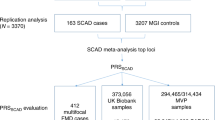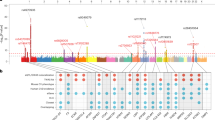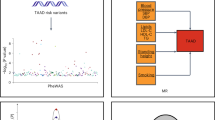Abstract
Cervical artery dissection (CeAD), a mural hematoma in a carotid or vertebral artery, is a major cause of ischemic stroke in young adults although relatively uncommon in the general population (incidence of 2.6/100,000 per year)1. Minor cervical traumas, infection, migraine and hypertension are putative risk factors1,2,3, and inverse associations with obesity and hypercholesterolemia are described3,4. No confirmed genetic susceptibility factors have been identified using candidate gene approaches5. We performed genome-wide association studies (GWAS) in 1,393 CeAD cases and 14,416 controls. The rs9349379[G] allele (PHACTR1) was associated with lower CeAD risk (odds ratio (OR) = 0.75, 95% confidence interval (CI) = 0.69–0.82; P = 4.46 × 10−10), with confirmation in independent follow-up samples (659 CeAD cases and 2,648 controls; P = 3.91 × 10−3; combined P = 1.00 × 10−11). The rs9349379[G] allele was previously shown to be associated with lower risk of migraine and increased risk of myocardial infarction6,7,8,9. Deciphering the mechanisms underlying this pleiotropy might provide important information on the biological underpinnings of these disabling conditions.
This is a preview of subscription content, access via your institution
Access options
Subscribe to this journal
Receive 12 print issues and online access
$209.00 per year
only $17.42 per issue
Buy this article
- Purchase on Springer Link
- Instant access to full article PDF
Prices may be subject to local taxes which are calculated during checkout

Similar content being viewed by others
References
Debette, S. & Leys, D. Cervical-artery dissections: predisposing factors, diagnosis, and outcome. Lancet Neurol. 8, 668–678 (2009).
Rubinstein, S.M., Peerdeman, S.M., van Tulder, M.W., Riphagen, I. & Haldeman, S. A systematic review of the risk factors for cervical artery dissection. Stroke 36, 1575–1580 (2005).
Debette, S. et al. Association of vascular risk factors with cervical artery dissection and ischemic stroke in young adults. Circulation 123, 1537–1544 (2011).
Arnold, M. et al. Vascular risk factors and morphometric data in cervical artery dissection: a case-control study. J. Neurol. Neurosurg. Psychiatry 80, 232–234 (2009).
Debette, S. & Markus, H.S. The genetics of cervical artery dissection: a systematic review. Stroke 40, e459–e466 (2009).
Kathiresan, S. et al. Genome-wide association of early-onset myocardial infarction with single nucleotide polymorphisms and copy number variants. Nat. Genet. 41, 334–341 (2009).
Deloukas, P. et al. Large-scale association analysis identifies new risk loci for coronary artery disease. Nat. Genet. 45, 25–33 (2013).
Freilinger, T. et al. Genome-wide association analysis identifies susceptibility loci for migraine without aura. Nat. Genet. 44, 777–782 (2012).
Anttila, V. et al. Genome-wide meta-analysis identifies new susceptibility loci for migraine. Nat. Genet. 45, 912–917 (2013).
Debette, S. et al. Differential features of carotid and vertebral artery dissections: the CADISP study. Neurology 77, 1174–1181 (2011).
Debette, S. et al. CADISP-genetics: an international project searching for genetic risk factors of cervical artery dissections. Int. J. Stroke 4, 224–230 (2009).
Wakefield, J. Bayes factors for genome-wide association studies: comparison with P-values. Genet. Epidemiol. 33, 79–86 (2009).
Pezzini, A. et al. Plasma homocysteine concentration, C677T MTHFR genotype, and 844ins68bp CBS genotype in young adults with spontaneous cervical artery dissection and atherothrombotic stroke. Stroke 33, 664–669 (2002).
Pezzini, A. et al. Migraine mediates the influence of C677T MTHFR genotypes on ischemic stroke risk with a stroke-subtype effect. Stroke 38, 3145–3151 (2007).
Longoni, M. et al. The ICAM-1 E469K gene polymorphism is a risk factor for spontaneous cervical artery dissection. Neurology 66, 1273–1275 (2006).
Pepin, M., Schwarze, U., Superti-Furga, A. & Byers, P.H. Clinical and genetic features of Ehlers-Danlos syndrome type IV, the vascular type. N. Engl. J. Med. 342, 673–680 (2000).
Low, S.K. et al. Genome-wide association study for intracranial aneurysm in the Japanese population identifies three candidate susceptible loci and a functional genetic variant at EDNRA. Hum. Mol. Genet. 21, 2102–2110 (2012).
Bilguvar, K. et al. Susceptibility loci for intracranial aneurysm in European and Japanese populations. Nat. Genet. 40, 1472–1477 (2008).
Yasuno, K. et al. Genome-wide association study of intracranial aneurysm identifies three new risk loci. Nat. Genet. 42, 420–425 (2010).
Lemaire, S.A. et al. Genome-wide association study identifies a susceptibility locus for thoracic aortic aneurysms and aortic dissections spanning FBN1 at 15q21.1. Nat. Genet. 43, 996–1000 (2011).
O'Donnell, C.J. et al. Genome-wide association study for coronary artery calcification with follow-up in myocardial infarction. Circulation 124, 2855–2864 (2011).
Lu, X. et al. Genome-wide association study in Han Chinese identifies four new susceptibility loci for coronary artery disease. Nat. Genet. 44, 890–894 (2012).
Hager, J. et al. Genome-wide association study in a Lebanese cohort confirms PHACTR1 as a major determinant of coronary artery stenosis. PLoS ONE 7, e38663 (2012).
Mehta, N.N. A genome-wide association study in Europeans and South Asians identifies 5 new loci for coronary artery disease. Circ. Cardiovasc. Genet. 4, 465–466 (2011).
Schunkert, H. et al. Large-scale association analysis identifies 13 new susceptibility loci for coronary artery disease. Nat. Genet. 43, 333–338 (2011).
Coronary Artery Disease (C4D) Genetics Consortium. A genome-wide association study in Europeans and South Asians identifies five new loci for coronary artery disease. Nat. Genet. 43, 339–344 (2011).
Bevan, S. et al. Genetic heritability of ischemic stroke and the contribution of previously reported candidate gene and genomewide associations. Stroke 43, 3161–3167 (2012).
Bellenguez, C. et al. Genome-wide association study identifies a variant in HDAC9 associated with large vessel ischemic stroke. Nat. Genet. 44, 328–333 (2012).
Traylor, M. et al. Genetic risk factors for ischaemic stroke and its subtypes (the METASTROKE Collaboration): a meta-analysis of genome-wide association studies. Lancet Neurol. 11, 951–962 (2012).
Smyth, D.J. et al. Shared and distinct genetic variants in type 1 diabetes and celiac disease. N. Engl. J. Med. 359, 2767–2777 (2008).
Calvet, D. et al. Increased stiffness of the carotid wall material in patients with spontaneous cervical artery dissection. Stroke 35, 2078–2082 (2004).
Golledge, J. & Eagle, K.A. Acute aortic dissection. Lancet 372, 55–66 (2008).
Norman, P.E., Davis, T.M., Le, M.T. & Golledge, J. Matrix biology of abdominal aortic aneurysms in diabetes: mechanisms underlying the negative association. Connect. Tissue Res. 48, 125–131 (2007).
Shantikumar, S., Ajjan, R., Porter, K.E. & Scott, D.J. Diabetes and the abdominal aortic aneurysm. Eur. J. Vasc. Endovasc. Surg. 39, 200–207 (2010).
Callaghan, F.M. et al. Wall stress of the cervical carotid artery in patients with carotid dissection: a case-control study. Am. J. Physiol. Heart Circ. Physiol. 300, H1451–H1458 (2011).
Kurth, T. et al. Headache, migraine, and structural brain lesions and function: population based Epidemiology of Vascular Ageing-MRI study. Br. Med. J. 342, c7357 (2011).
Chasman, D.I. et al. Genome-wide association study reveals three susceptibility loci for common migraine in the general population. Nat. Genet. 43, 695–698 (2011).
Metso, T.M. et al. Migraine in cervical artery dissection and ischemic stroke patients. Neurology 78, 1221–1228 (2012).
Allen, P.B., Greenfield, A.T., Svenningsson, P., Haspeslagh, D.C. & Greengard, P. Phactrs 1–4: a family of protein phosphatase 1 and actin regulatory proteins. Proc. Natl. Acad. Sci. USA 101, 7187–7192 (2004).
Allain, B. et al. Neuropilin-1 regulates a new VEGF-induced gene, Phactr-1, which controls tubulogenesis and modulates lamellipodial dynamics in human endothelial cells. Cell. Signal. 24, 214–223 (2012).
Jarray, R. et al. Depletion of the novel protein PHACTR-1 from human endothelial cells abolishes tube formation and induces cell death receptor apoptosis. Biochimie 93, 1668–1675 (2011).
Fils-Aimé, N. et al. MicroRNA-584 and the protein phosphatase and actin regulator 1 (PHACTR1), a new signaling route through which transforming growth factor-β mediates the migration and actin dynamics of breast cancer cells. J. Biol. Chem. 288, 11807–11823 (2013).
Goumans, M.J., Liu, Z. & ten Dijke, P. TGF-β signaling in vascular biology and dysfunction. Cell Res. 19, 116–127 (2009).
Loeys, B.L. et al. A syndrome of altered cardiovascular, craniofacial, neurocognitive and skeletal development caused by mutations in TGFBR1 or TGFBR2. Nat. Genet. 37, 275–281 (2005).
Zhang, X. et al. Genetic associations with expression for genes implicated in GWAS studies for atherosclerotic cardiovascular disease and blood phenotypes. Hum. Mol. Genet. 23, 782–795 (2014).
Westra, H.J. et al. Systematic identification of trans eQTLs as putative drivers of known disease associations. Nat. Genet. 45, 1238–1243 (2013).
Bown, M.J. et al. Abdominal aortic aneurysm is associated with a variant in low-density lipoprotein receptor–related protein 1. Am. J. Hum. Genet. 89, 619–627 (2011).
Lee, V.H., Brown, R.D. Jr., Mandrekar, J.N. & Mokri, B. Incidence and outcome of cervical artery dissection: a population-based study. Neurology 67, 1809–1812 (2006).
Pruim, R.J. et al. LocusZoom: regional visualization of genome-wide association scan results. Bioinformatics 26, 2336–2337 (2010).
Price, A.L. et al. Principal components analysis corrects for stratification in genome-wide association studies. Nat. Genet. 38, 904–909 (2006).
Thomas, D. Gene—environment-wide association studies: emerging approaches. Nat. Rev. Genet. 11, 259–272 (2010).
Acknowledgements
The authors thank the staff and participants of all CADISP centers for their important contributions. The CADISP study has been supported by INSERM, Lille 2 University, Institut Pasteur de Lille and Lille University Hospital and received funding from the European Regional Development Fund (FEDER funds) and Région Nord-Pas-de-Calais in the framework of Contrat de Projets Etat-Region 2007–2013 Région Nord-Pas-de-Calais (grant 09120030), Centre National de Génotypage, the Emil Aaltonen Foundation, the Paavo Ilmari Ahvenainen Foundation, the Helsinki University Central Hospital Research Fund, the Helsinki University Medical Foundation, the Päivikki and Sakari Sohlberg Foundation, the Aarne Koskelo Foundation, the Maire Taponen Foundation, the Aarne and Aili Turunen Foundation, the Lilly Foundation, the Alfred Kordelin Foundation, the Finnish Medical Foundation, the Orion Farmos Research Foundation, the Maud Kuistila Foundation, the Finnish Brain Foundation, the Biomedicum Helsinki Foundation, Projet Hospitalier de Recherche Clinique Régional, Fondation de France, Génopôle de Lille, Adrinord, the Basel Stroke Funds, the Käthe-Zingg-Schwichtenberg-Fonds of the Swiss Academy of Medical Sciences and the Swiss Heart Foundation.
L.H.B., S.T.E. and P.A.L. were supported, in part, by a grant from the Swiss National Science Foundation (33CM30-124119). S.D. is supported by a Chair of Excellence from the French National Research Agency (ANR). S.D. and M.D. are supported by a grant from the Leducq Foundation. M.D. is supported by the Vascular Dementia Research Foundation. I.F.-C. is supported by the Miguel Servet programme (CP12/03298) from the Spanish Ministry of Health (Instituto de Salud Carlos III). G.K. is a member of the Deutsche Forschungsgemeinschaft Cluster of Excellence 'Inflammation at Interfaces'. P.S. is supported by a Department of Health (UK) senior fellowship. A.M.S. is supported by the American Heart Association/American Stroke Association National Clinical Research Program (AHA 3CRP14140001). V.T. is supported by Fonds Wetenschappelijk Onderzoek Flanders.
More detailed acknowledgments can be found in the Supplementary Note.
Author information
Authors and Affiliations
Consortia
Contributions
Study conception and design were performed by S.D., Y.K., M.L., D.L., P.A. and J.D. Acquisition of data was carried out by S.D., T.M.M., M.K., S.T.E., A. Pezzini, V.T., H.S.M., M.D., R.D., E.T., A.M.S., Y.S., S.A., Y.B., V.C., A.B., A.G., M.S., J.C., C. Lamy, E.M., S.B., L.H.B., A.J.G., P.M., J.J.M., P.S., E.B., B.G., E.G.v.d.H., I.F.-C., K.J., I.W., M.A.N., F.-E.D.L., C.J., Y.-C.C., A.J.M., C. Lichy, L.D., L.K., M.N., P.A.L., T. Brandt, G.B.B., H.-E.W., C.G., T. Böttcher, M.C., D.A., M.A.I., M.M.B.B., A. Padovani, J.F.M., G.K., A.R., B.B.W., E.-B.R., D.Z., T.T., M.L., D.L., P.A. and J.D. Statistical analysis and interpretation of the data were performed by S.D., Y.K., C.W., Y.-C.C., G.C., M.L., P.A. and J.D. The manuscript was drafted by S.D., Y.K., M.L., P.A. and J.D. Critical revision of the manuscript was performed by S.D., Y.K., T.M.M., S.T.E., C.W., M.L., P.A., J.D., A. Pezzini, V.T., H.S.M., E.T., A.M.S., J.C., J.J.M., P.S., I.F.-C., A.J.M., P.A.L., M.A.I., D.Z., T.T., M.L., D.L., P.A. and J.D. Annotation for expression quantitative trait loci was performed by A.D.J. Funding was obtained by S.D., S.T.E., A. Pezzini, V.T., H.S.M., M.D., S.B., A.J.G., P.M., J.J.M., P.S., B.G., F.-E.D.L., C.J., P.A.L., G.B.B., H.-E.W., M.C., D.A., M.M.B.B., J.F.M., A.R., B.B.W., E.-B.R., D.Z., T.T., M.L., D.L., P.A. and J.D.
Corresponding author
Ethics declarations
Competing interests
The authors declare no competing financial interests.
Additional information
A list of contributing members appears in the Supplementary Note.
A list of members and affiliations appears in the Supplementary Note.
Supplementary information
Supplementary Text and Figures
Supplementary Figures 1–8, Supplementary Tables 1–22 and Supplementary Note (PDF 6286 kb)
Rights and permissions
About this article
Cite this article
Debette, S., Kamatani, Y., Metso, T. et al. Common variation in PHACTR1 is associated with susceptibility to cervical artery dissection. Nat Genet 47, 78–83 (2015). https://doi.org/10.1038/ng.3154
Received:
Accepted:
Published:
Issue Date:
DOI: https://doi.org/10.1038/ng.3154
This article is cited by
-
Advancements in the Genetics of Spontaneous Coronary Artery Dissection
Current Cardiology Reports (2023)
-
PHACTR1 genetic variability is not critical in small vessel ischemic disease patients and PcomA recruitment in C57BL/6J mice
Scientific Reports (2021)
-
Genetic investigation of fibromuscular dysplasia identifies risk loci and shared genetics with common cardiovascular diseases
Nature Communications (2021)
-
Updates in Spontaneous Coronary Artery Dissection
Current Cardiology Reports (2020)
-
39/w mit Kopfschmerzen, fluktuierender Sehstörung und transienter Aphasie
DGNeurologie (2020)



